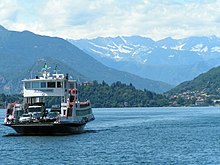


A waterway is any navigable body of water. Broad distinctions are useful to avoid ambiguity, and disambiguation will be of varying importance depending on the nuance of the equivalent word in other ways. A first distinction is necessary between maritime shipping routes and waterways used by inland water craft. Maritime shipping routes cross oceans and seas, and some lakes, where navigability is assumed, and no engineering is required, except to provide the draft for deep-sea shipping to approach seaports (channels), or to provide a short cut across an isthmus; this is the function of ship canals. Dredged channels in the sea are not usually described as waterways. There is an exception to this initial distinction, essentially for legal purposes, see under international waters.
Where seaports are located inland, they are approached through a waterway that could be termed "inland" but in practice is generally referred to as a "maritime waterway" (examples Seine Maritime, Loire Maritime, Seeschiffahrtsstraße Elbe). The term "inland waterway" refers to navigable rivers and canals designed to be used by inland waterway craft only, implicitly of much smaller dimensions than seagoing ships.
In order for a waterway to be navigable, it must meet several criteria:
- it must be deep enough to accommodate vessels loading to the design draft;
- it must be wide enough to allow passage of the vessels with the design width or beam;
- it must be free of obstacles to navigation such as waterfalls and rapids, or offer a way around them (such as canal locks or boat lifts);
- its current must be mild enough to allow vessels to make headway upstream without undue difficulty;
- the wave height (on lakes) must not exceed the value for which the class of vessel is designed.
Vessels using waterways vary from small animal-drawn barges to immense ocean tankers and ocean liners, such as cruise ships.
In order to increase the importance of inland waterway transport, the European Commission presented a 35-point action plan in June 2021. The main goals are to increase the amount of goods moved through Europe's rivers and canals and to speed up the switch to zero-emission barges by 2050. This is in accordance with the Sustainable and Smart Mobility Strategy and the European Green Deal, which set the target of boosting inland canal and short-sea shipping by 25% by 2030 and by 50% by 2050.[1]

